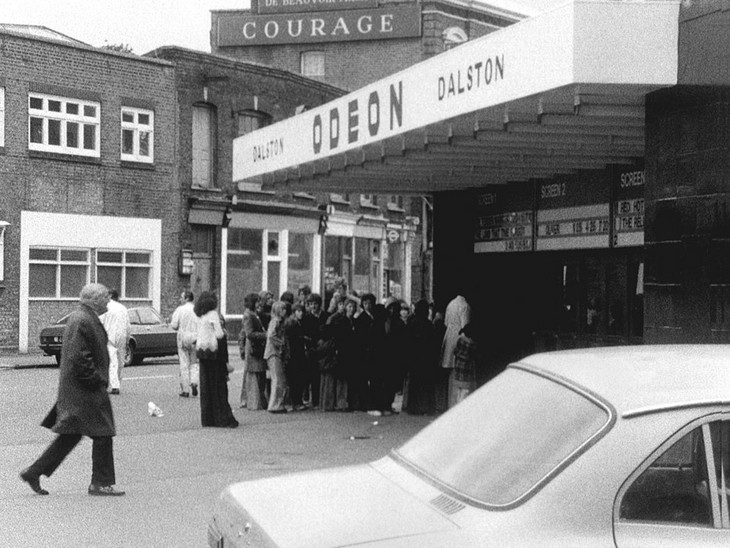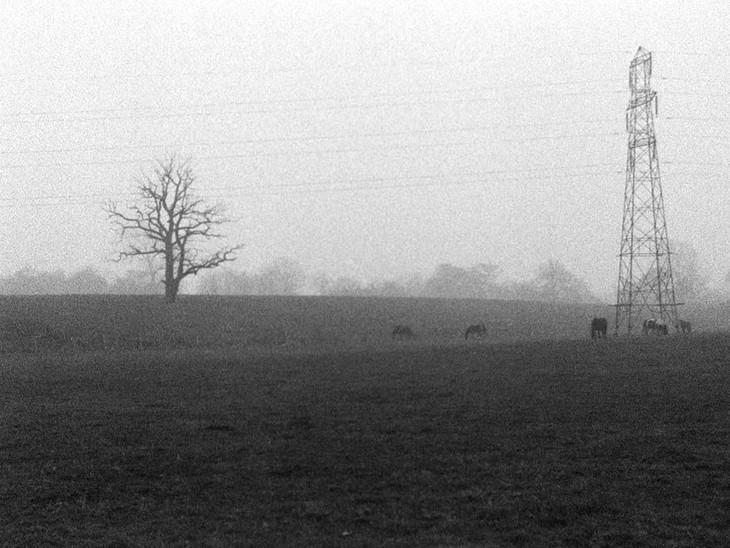The Girl Chewing Gum 1976 by John Smith
Fig.1
John Smith
The Girl Chewing Gum
1976
Film, 16 mm, black and white, and sound
12 min
Courtesy the artist and Tanya Leighton Gallery, Berlin
John Smith’s The Girl Chewing Gum (fig.1) is many things: a twelve-minute 16 mm film consisting of only two shots, a testimony to how complexity can arise out of a sparse economy of means, an allegory of cinema, a critique of documentary naturalism, an interrogation of language-image relations, a record of an East London neighbourhood, a classic avant-garde film, an art world hit some thirty-five years after its debut, and more besides. Yet before discussing these elements, some description is in order.
The film opens with a static long shot of a London street, facing westward across Kingsland Road where it intersects with Tottenham Road and Stamford Road in Dalston. This take lasts approximately ten minutes, as much film as the magazine of a 16 mm camera can hold. On the soundtrack, a burglar alarm rings over ambient street noises. A male voiceover – Smith’s own – begins: ‘Slowly move the trailer to the left. And I want the little girl to run across – now’. As he delivers these commands, the corresponding actions occur in the frame. Invisible behind the camera, this director-narrator continues to rule over the represented scene. After two minutes of orchestrating the entrances and exits of passers-by, Smith delivers a different and rather curious kind of instruction: ‘I want everything to sink slowly down as the five boys come by’. As the camera tilts upward, the world – or rather, the representation of the world produced by the apparatus – sinks. This, of course, happens all the time in the cinema, but is usually apprehended as a product of the camera’s mobile gaze rather than the movement of normally stationary buildings. Paradoxically and rather humorously, Smith foregrounds the mediating presence of the camera not by naming its actions (‘Tilt up’), but by acting as if it does not exist – as if the director had a control over the onscreen world so absolute, direct and godlike that buildings sink and elevate according to his whims. If the first two minutes of The Girl Chewing Gum had skirted the possibility that the scene was indeed being directed by the off-screen voice, the description of this camera movement in terms of its pictorial effect rather than its cause signals to the viewer that something is awry. What might have appeared as an assertion of control becomes legible as a critique of the fantasy of control.
The upward tilt rests on a clock, which is then directed ‘to move jerkily towards’ the filmmaker as the camera zooms in. The voiceover continues, ‘I want the long hand to move at a rate of one revolution every hour, and I want the short hand to move at the rate of one revolution every twelve hours. Now, two pigeons fly across and everything comes up again until the girl chewing gum walks across from the left’. By the time the camera tilts down and the titular girl walks into the frame, The Girl Chewing Gum has done away with whatever illusionism it cultivated in its earliest moments and has resituated itself firmly as a reflexive interrogation of cinematic conventions. As the film goes on, Smith’s investigation of the manipulability of meaning becomes increasingly elaborate. The voiceover begins to remark upon details of the scene invisible to the camera, such as the title of the magazine carried under the arm of a man in the distance (Exchange and Mart). It offers information about the figures onscreen indiscernible from appearance alone, such as the fact that one man is a dentist who is on his way to the bank. Either this voice possesses a complete knowledge of all aspects of the filmic world, or – more likely – he is simply making it up, with the result that what we are told we are seeing and what we actually see do not coincide. The voice had initially seemed to direct the scene, cueing the action according to a desired choreography. But as the film continues, the voice is increasingly overtaken by a drive to fabulation: the viewer is in thrall to an unreliable narrator who weaves stories that, while not incompatible with anything seen onscreen, are not there to be found in the image-track alone. The so-called dentist Smith shot in Dalston that afternoon might in fact be a barrister on his way to the pub.

John Smith
The Girl Chewing Gum 1976 (film still)
Courtesy the artist and Tanya Leighton Gallery, Berlin
Fig.2
John Smith
The Girl Chewing Gum 1976 (film still)
Courtesy the artist and Tanya Leighton Gallery, Berlin

John Smith
The Girl Chewing Gum 1976 (film still)
Courtesy the artist and Tanya Leighton Gallery, Berlin
Fig.3
John Smith
The Girl Chewing Gum 1976 (film still)
Courtesy the artist and Tanya Leighton Gallery, Berlin
Just past the eight-minute mark, this unreliability is amplified as the viewer learns that the narrator is not present in Dalston at all; rather, he is ‘shouting into a microphone on the edge of a field near Letchmore Heath, about fifteen miles from the building you’re looking at’. The burglar alarm and street noise disappear as he begins to describe the scene around him in the field, accompanied by continued images of Dalston. The account of Letchmore Heath at first seems to offer the viewer a moment of trustworthy description. One might for a moment think that the narrator has been unmasked and now speaks the truth. But his description of the field turns out to contain absurdist improbabilities that rely on a distortion of scale: he catches sight of blackbird with a nine-foot wingspan and a man carrying a helicopter in his pocket. He begins to speak about Dalston once more, but the soundtrack remains otherwise quiet. He describes a man who has just robbed the local post office and who is carrying a revolver in a sweaty hand inside his raincoat pocket – none of which, aside from the fact that the man who appears onscreen at that moment is wearing a raincoat and has his hands in his pockets, is verifiable by sight. ‘The burglar alarm is still ringing’, the voiceover says, but it cannot be heard. The voice stays quiet as the camera holds on a cinema queue for around one minute before zooming out to reveal the entire building, the Dalston Odeon (fig.2). (The film on view that day is The Land That Time Forgot, a 1975 lost world fantasy based on the American writer Edgar Rice Burrows’s 1918 serialised novel of the same name.) The Girl Chewing Gum concludes with a two-minute, 360-degree pan across Letchmore Heath, accompanied by a soundtrack of Dalston street noises, including the alarm (fig.3). The man with the helicopter in his pocket and the giant blackbird are nowhere to be seen. Perhaps they are out of frame, or perhaps they were never there.
The Girl Chewing Gum was made during a rich period of avant-garde practice in which many filmmakers, both in Britain and beyond, sought to dismantle the illusionist transparency of dominant cinema. Most of those invested in this project took up a focus on filmic materiality, refusing the possibility of a ‘window on the world’ in favour of a modernist concern with the cinematic apparatus. In The Girl Chewing Gum, Smith proceeded somewhat differently: his interest lay above all in interrogating the conventions that structured cinematic signification through a reflexive deployment of those very same conventions, rather than any out-and-out negation of them. The Girl Chewing Gum offers a playful yet trenchant exploration of the role that language – and particularly voiceover – plays in the production of filmic meaning and asserts the absolute impossibility of immediacy and neutrality. But despite its anti-illusionist criticality, the film remains deeply engaged with narrative and humour, two terms not often associated with British avant-garde cinema of the 1970s. Indeed, it was Smith’s concern that the film might be taken simply as a joke that led him to conclude the work with several humourless minutes, what he has referred to as ‘thinking time’.1
The five sections that follow will adopt a series of mutually enriching perspectives on this classic, multi-faceted work in order to situate it historically, explicate its intersections with film and visual theory, and explore the changing conditions of its exhibition and reception since the time of its production. It will begin by providing a context for the emergence of the film before considering its connections with and divergences from structural/materialist filmmaking and its complex interrogation of language-image relationships. Following this, a conversation between John Smith and Patrick Wright will take up The Girl Chewing Gum as a local film, one that documents a neighbourhood that has undergone immense changes since 1976 and has been home to the filmmaker for much of his life. The final section will address the contemporary status of the film in the gallery and museum context, where it has been the subject of enthusiastic embrace in recent years, culminating in Tate’s acquisition of the work in 2010.
Notes
How to cite
Erika Balsom, ‘The Girl Chewing Gum 1976 by John Smith’, September 2015, in Erika Balsom (ed.), In Focus: 'The Girl Chewing Gum' 1976 by John Smith, Tate Research Publication, 2015, https://www
